The latest set of observations by Simon for the ExoClock project of the exoplanet WASP-92b which orbits its parent star WASP-92, an F7 star, every 2.17 days.
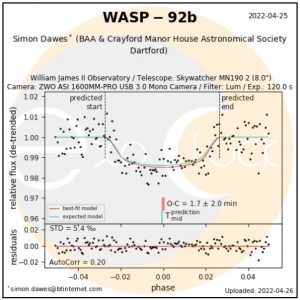
Astronomy every Thursday
The latest set of observations by Simon for the ExoClock project of the exoplanet WASP-92b which orbits its parent star WASP-92, an F7 star, every 2.17 days.

The latest exoplanet transit from Simon Dawes for the ExoClock project. WASP 113 is a 11.7 magnitude star and Exoplanet WASP- 113b orbits it every 4.5days with a drop of 10/1000ths of a magnitude. WASP 113 is a G type star of 1.3 Solar Masses and the exoplanet WASP-113b is half the mass of Jupiter.
Crayford members have now contributed 110 light curves.
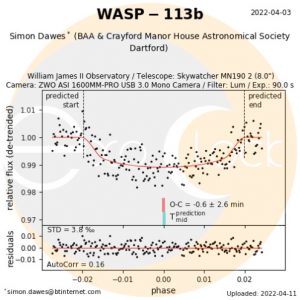
Another for the ExoClock project......
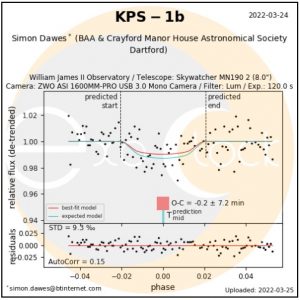
KPS-1b orbits a star similar to the Sun with a period of 40 hours.
The mass and size of the exoplanet KPS-1b are close to the characteristics of Jupiter, but it is located very close to its parent star so the temperature of the atmosphere KPS-1b is much higher than that of Jupiter.
The discovery was made by the prototype Kourovka Planet Search (KPS) project, which used wide-field CCD data gathered by amateur astronomers using readily available and relatively affordable equipment with astronomers from Belgium, USA, England, France, the Netherlands, Turkey, Portugal, Lithuania, Italy and Canada contributing.
The night Simon did the observations for KPS - 1b Simon said ''the transparency was low - when I left the society meeting you could see the water particles in the air in the headlamp and under the street lights, so I'm pleased I got anything at all!''
Simon Dawes has been busy again with his exoplanet observations for the ExoClock project. Below are his observations.
Exoplanet HAT-P-44b was discovered in 2013 by the HATNet transit survey. Its mass is 0.39 mass of Jupiter and has an orbital period of 4.3 days.
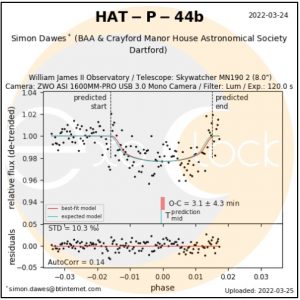
Of Exoplanet WASP -148b Simon said ''This is a 11.8 magnitude star and the dip is 8 thousandths of a magnitude - I think it must be one of the most challenging to observe with my 8" telescope, but the conditions were obviously good and I got this fit very quickly (this is the one I said at last night's meeting that I hadn't submitted because I wanted to see if I could improve - this is the improved reduction) . WASP 148b is a hot Jupiter, there is another planet in this system (WASP 148c with a 35 day orbit) and the gravitational tug of the outer planet (WASP-148c) perturbs the orbit of the hot Jupiter WASP-148b''
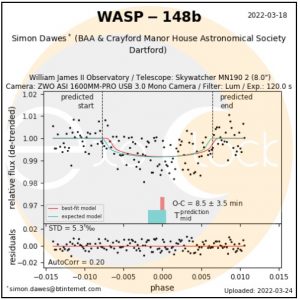
These are the latest exoplanet observations by Martin Crow.
TOI-1298 b is a gas giant exoplanet that orbits a G-type star TOI -1298 in the constellation of Ursa Minor. Its mass is 0.356 Jupiters. It takes 4.5 days to complete one orbit of its star and is 0.059 AU from its star. TOI-1298 b was discovered by the Transiting Exoplanet Survey Satellite (TESS) observatory, in 2021-09.
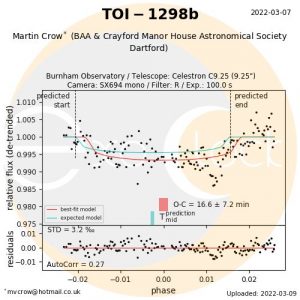
Martin wrote ''The observations were done as part of the ExoClock synchronous observations group. This particular transit has a depth of <5 thousandths of a magnitude!! To get useful data for this target would require a telescope diameter of at least 400mm or greater. My telescope at 235mm is too small although the dip is clearly detectable buried in the noise. The aim of the project is to combine three or more data sets from similar sized small instruments taken on the same night to increase the accuracy to that achievable with a bigger telescope. This method will help to make otherwise impossible targets viable for the majority of instruments registered on the ExoClock project.''
Three more exoplanets have been observed by Simon for the ExoClock project - KELT 23ab, HAT P 13b and KPS 1b.
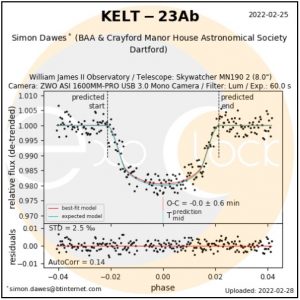
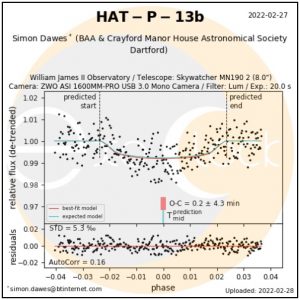
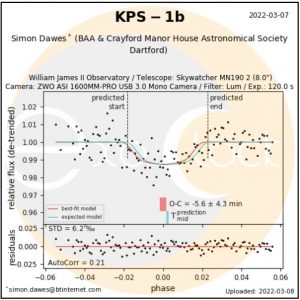
Another exoplanet transit observed by Simon Dawes of Qatar 8b for the ExoClock project. Qatar-8b is just over a third of Jupiter's mass (0.37) and is considered a "hot Saturn." It takes less than four days to orbit its star, which is about 900 light-years from Earth.
Simon said it was a tricky one to process, but the result came out very well with a depth almost identical to the published data. Well done Simon.
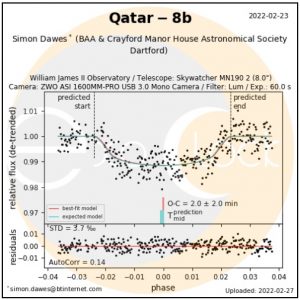
Here is the latest exoplanet transit observed by member & trustee Simon Dawes for the ExoClock project. It is of WASP-12b a doomed EGG shaped planet.
WASP-12b is a hot Jupiter that orbits so close to its parent star, it is being torn apart and it takes this sizzling gas giant alien world only 1.1 days to completely circle its parent star!
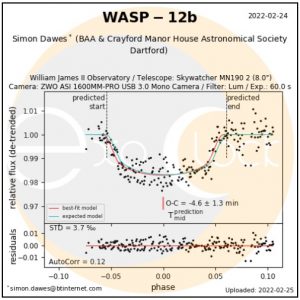
The doomed planet is being eaten by its parent star, according to observations made by NASA's Hubble Space Telescope, the Cosmic Origins Spectrograph (COS). The planet may only have another 10 million years left before it is completely devoured.
The planet WASP-12b, is so close to its sun like parent star that it is superheated to nearly 2,800 degrees Fahrenheit and stretched into an egg shape by enormous tidal forces. The atmosphere has ballooned to nearly three times Jupiter's radius and is spilling material onto the parent star. The planet is 40 percent more massive than Jupiter.
"We see a huge cloud of material around the planet, which is escaping and will be captured by the star. We have identified chemical elements never before seen on planets outside our own solar system," says team leader Carole Haswell of The Open University in Great Britain.
WASP-12b reflects just 6% of the light that shines on its surface. As a result, the exoplanet has been described as "black as asphalt", and as "pitch black."
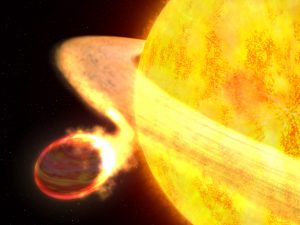
Photo Credit: NASA/ESA/G Bacon artist's concept of WASP-12b & parent star.
Simon along with other amateur and professional astronomers have been observing exo-planet transits as part of the ExoClock project for the Ariel Mission due for launch in 2028. Each observation takes between 4 and 5 hours typically so is quite a commitment. Well done Simon.
The Ariel mission will observe spectroscopically around 1000 exoplanets to further characterise their atmospheres. For the mission to be as efficient as possible, a good knowledge of the planets’ ephemerides is needed before its launch in 2028. While ephemerides for some planets are being refined on a per-case basis, an organised effort to collectively verify or update them when necessary does not exist. In this study, we introduce the ExoClock project, an open, integrated and interactive platform with the purpose of producing a confirmed list of ephemerides for the planets that will be observed by Ariel.
Click here for more information about the project.
[et_pb_section fb_built="1" _builder_version="4.7.4" _module_preset="default" global_colors_info="{}"][et_pb_row _builder_version="4.7.4" _module_preset="default" global_colors_info="{}"][et_pb_column type="4_4" _builder_version="4.7.4" _module_preset="default" global_colors_info="{}"][et_pb_text _builder_version="4.7.4" _module_preset="default" global_colors_info="{}"]
Members Simon Dawes and Martin Crow have been named as contributors on a scientific paper published this week, Martin and Simon along with other amateur and professional astronomers have been observing exo-planet transits - each observation takes between 4 and 5 hours typically so is quite a commitment. Well done Mrtin and Simon and all the other amateur astronomers who submitted observations.
The Ariel mission will observe spectroscopically around 1000 exoplanets to further characterise their atmospheres. For the mission to be as efficient as possible, a good knowledge of the planets' ephemerides is needed before its launch in 2028. While ephemerides for some planets are being refined on a per-case basis, an organised effort to collectively verify or update them when necessary does not exist. In this study, we introduce the ExoClock project, an open, integrated and interactive platform with the purpose of producing a confirmed list of ephemerides for the planets that will be observed by Ariel. The project has been developed in a manner to make the best use of all available resources: observations reported in the literature, observations from space instruments and, mainly, observations from ground-based telescopes, including both professional and amateur observatories. To facilitate inexperienced observers and at the same time achieve homogeneity in the results, we created data collection and validation protocols, educational material and easy to use interfaces, open to everyone. ExoClock was launched in September 2019 and now counts over 140 participants from more than 15 countries around the world. In this release, we report the results of observations obtained until the 15h of April 2020 for 119 Ariel candidate targets. In total, 632 observations were used to either verify or update the ephemerides of 83 planets. Additionally, we developed the Exoplanet Characterisation Catalogue (ECC), a catalogue built in a consistent way to assist the ephemeris refinement process. So far, the collaborative open framework of the ExoClock project has proven to be highly efficient in coordinating scientific efforts involving diverse audiences. Therefore, we believe that it is a paradigm that can be applied in the future for other research purposes, too.
Full article is available here
[/et_pb_text][/et_pb_column][/et_pb_row][/et_pb_section]
[et_pb_section fb_built="1" _builder_version="4.4.1" global_colors_info="{}"][et_pb_row _builder_version="4.4.1" global_colors_info="{}"][et_pb_column type="4_4" _builder_version="4.4.1" global_colors_info="{}"][et_pb_text _builder_version="4.4.1" global_colors_info="{}"]
HAT-P-30b is a transiting hot Jupiter around a 1.25 solar mass star in the constellation of Hydra near the boarder of cancer.
Martin Crow and Simon Dawes observed this exo-planet transiting its parent start part of the exoclock project, to refine transit predictions for the Aerial space craft wich will be observing exoplanet transits to learn more about these enigmatic planets.
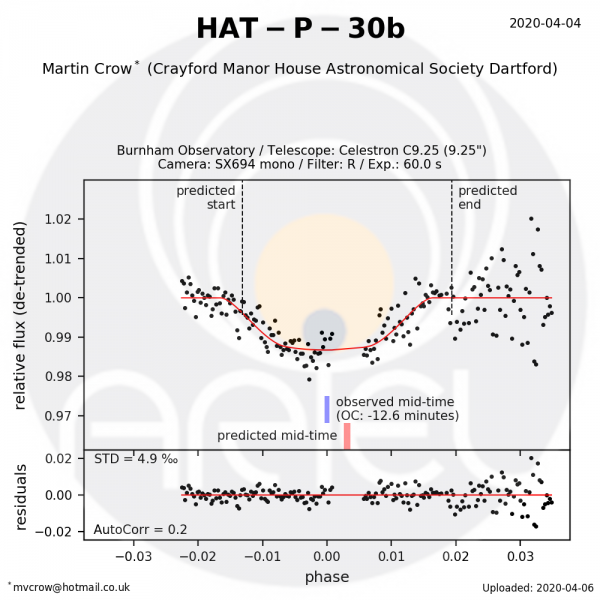
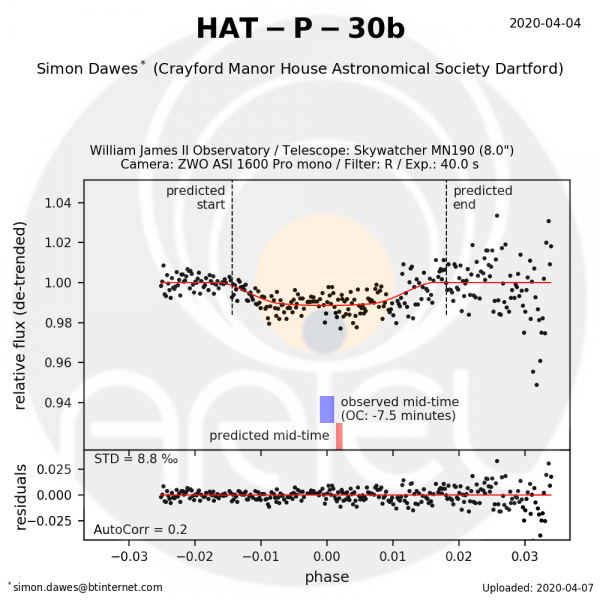
[/et_pb_text][/et_pb_column][/et_pb_row][/et_pb_section]